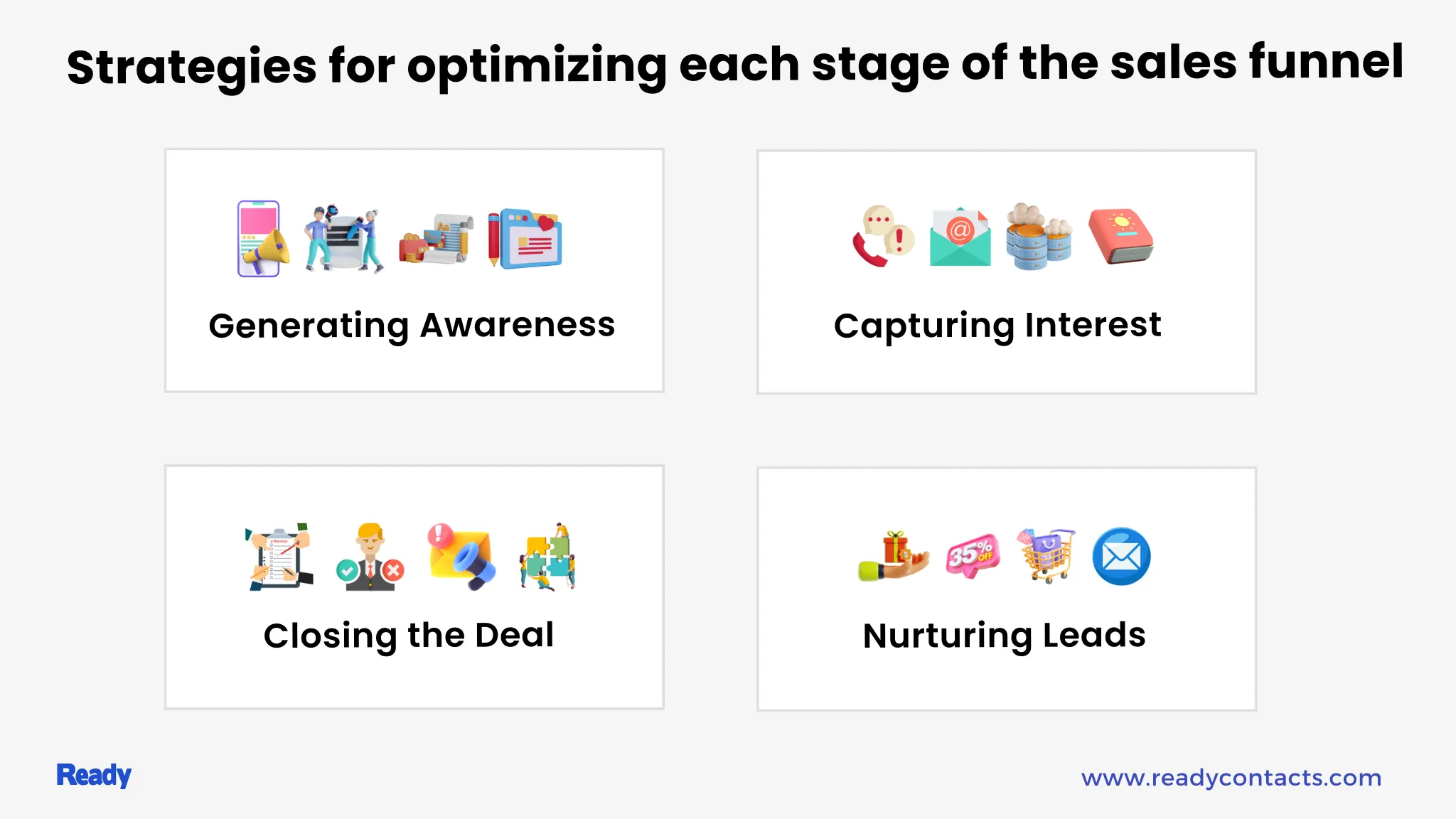
In the world of sales and marketing, understanding the dynamics of the sales funnel is crucial for driving business growth and maximizing revenue.
A sales funnel represents the journey a potential customer goes through, starting from the initial stage of awareness and ending with a purchase decision.
By understanding the different stages of the funnel and implementing effective strategies at each stage, businesses can optimize their sales process and increase conversion rates.
In this article, we will delve into the intricacies of sales funnel dynamics and explore strategies for maximizing its potential.
The stages of a sales funnel
A sales funnel typically consists of five main stages: awareness, interest, consideration, decision, and action. Let's explore each stage in detail.

- Awareness: At the top of the funnel, the goal is to generate awareness and attract potential customers. This stage involves creating brand awareness through various marketing channels, such as social media, content marketing, and advertising.
- Interest: Once a potential customer becomes aware of a product or service, they move into the interest stage. Here, the focus is on capturing the interest of the prospect and providing them with more information about the offering. This can be achieved through engaging content, lead magnets, and targeted email campaigns.
- Consideration: In the consideration stage, prospects are evaluating different options and comparing them. The goal is to position your product or service as the best solution to their needs. Testimonials, case studies, and product demonstrations can be effective in influencing the prospect's decision-making process.
- Decision: At this stage, the prospect is ready to make a decision and become a customer. The emphasis is on providing persuasive offers, such as discounts, free trials, or limited-time promotions, to encourage them to take action and make a purchase.
- Action: The final stage of the sales funnel is where the prospect converts into a paying customer. This could involve completing a purchase, signing up for a subscription, or requesting a quote. The focus shifts towards delivering an exceptional customer experience and ensuring a smooth transition from prospect to customer.
Mapping the buyer's journey
To effectively manage the sales funnel, it's important to understand the buyer's journey and tailor marketing efforts accordingly. The buyer's journey can be divided into three main stages: top of the funnel (TOFU), middle of the funnel (MOFU), and bottom of the funnel (BOFU).

- Top of the funnel (TOFU): At this stage, potential customers are in the early research phase and are seeking information. To attract and engage them, businesses should focus on creating educational content, blog posts, videos, and social media campaigns that provide value and address their pain points.
- Middle of the funnel (MOFU): In the middle of the funnel, prospects have moved past the initial research stage and are actively considering their options. This is an opportunity to nurture leads and provide more detailed information about the product or service. Webinars, whitepapers, and case studies can be effective in building trust and credibility.
- Bottom of the funnel (BOFU): At the bottom of the funnel, prospects are ready to make a decision and are actively comparing different offerings. Here, businesses should focus on providing personalized and targeted content, such as product demos, free trials, or consultations, to help prospects make the final purchase decision.
Strategies for optimizing each stage of the sales funnel
To optimize the performance of the sales funnel, businesses can implement specific strategies at each stage. Let's explore some effective approaches for each stage:

- Generating awareness: Utilize social media platforms, content marketing, and paid advertising to create brand awareness and reach a wider audience. Engaging blog posts, informative videos, and eye-catching visuals can help attract potential customers.
- Capturing interest: Offer valuable content in exchange for contact information, such as email addresses, to build a database of leads. Implement lead magnets, such as e-books, guides, or templates, to capture the interest of prospects and encourage them to provide their details.
- Nurturing leads: Develop a lead nurturing strategy to stay top-of-mind with prospects and guide them through the decision-making process. Use email marketing automation to send personalized and targeted messages that address their specific pain points and provide relevant solutions.
- Closing the deal: Provide incentives, such as discounts or limited-time offers, to encourage prospects to take action and make a purchase. Implement an effective sales process, including follow-up emails or calls, to address any concerns and provide further assistance to close the deal successfully.
Tools and technologies for sales funnel management
Several tools and technologies are available to help businesses manage and optimize their sales funnels. Let's explore some key ones:
- Customer relationship management (CRM) systems: CRM systems, such as Salesforce, HubSpot, or Zoho CRM, help businesses organize and track customer interactions, manage leads, and automate sales processes.
- Marketing automation platforms: Platforms like Marketo, Mailchimp, or ActiveCampaign enable businesses to automate marketing tasks, including email campaigns, lead scoring, and lead nurturing, to streamline the sales funnel.
- Analytics and reporting tools: Tools like Google Analytics, Kissmetrics, or Mixpanel provide valuable insights into the performance of the sales funnel. Businesses can track key metrics, analyze customer behavior, and identify areas for improvement.
Key metrics to track in the sales funnel
Tracking key metrics is essential to measure the effectiveness of the sales funnel and make data-driven decisions. Here are some important metrics to monitor:
- Conversion rate: This metric indicates the percentage of leads that successfully convert into paying customers. It helps businesses understand the overall efficiency of the sales funnel and identify areas for improvement.
- Average deal size: The average deal size provides insights into the value of each customer. By tracking this metric, businesses can assess the revenue generated from different stages of the funnel and adjust their strategies accordingly.
- Customer acquisition cost (CAC): CAC represents the cost involved in acquiring a new customer. By tracking this metric, businesses can evaluate the effectiveness of their marketing and sales efforts and ensure that the cost of acquiring customers is within an acceptable range.
- Customer lifetime value (CLV): CLV is the predicted net profit generated by a customer over their entire relationship with a business. Tracking this metric helps businesses understand the long-term value of customers and allocate resources accordingly.
Common challenges in managing the sales funnel
Managing the sales funnel effectively can come with its own set of challenges. Let's explore some common hurdles businesses may face:
- Lack of alignment between marketing and sales: When marketing and sales teams are not aligned, leads can fall through the cracks. It's crucial to establish effective communication and collaboration between both teams to ensure a seamless transition from marketing-generated leads to sales opportunities.
- Poor lead quality: If the quality of leads entering the funnel is low, it can negatively impact conversion rates. Businesses need to implement lead qualification processes and ensure that marketing efforts are attracting qualified leads that are more likely to convert.
- Inefficient lead nurturing: Without a well-defined lead nurturing strategy, businesses may struggle to stay engaged with prospects and guide them through the sales funnel. It's important to provide valuable content and personalized communication to keep prospects interested and move them closer to making a purchase.
- Inadequate follow-up processes: Failing to follow up with leads in a timely and personalized manner can result in missed opportunities. Implementing an efficient follow-up process, including automated email sequences or CRM reminders, can help businesses stay on top of prospects' minds and increase conversion rates.
Tips for improving sales funnel performance
To improve the performance of the sales funnel, consider implementing the following tips:
- Streamline lead qualification processes: Develop clear criteria for lead qualification and ensure that marketing and sales teams are aligned on the definition of a qualified lead. This will help focus resources on leads with the highest potential for conversion.
- Personalize communication with leads: Tailor your messaging to the specific needs and pain points of each prospect. Use automation tools to send personalized emails and create targeted content that resonates with your audience.
- Provide valuable content throughout the buyer's journey: Create educational and informative content that addresses the challenges and questions prospects may have at each stage of the funnel. This will establish your business as a trusted authority and help build relationships with potential customers.
- Continuously analyze and optimize the funnel: Regularly review the performance of your sales funnel, track key metrics, and identify areas for improvement. Use A/B testing to experiment with different strategies and optimize conversion rates.
Conclusion
Understanding the dynamics of the sales funnel is essential for businesses looking to maximize their revenue and drive growth.
By mapping the buyer's journey, implementing effective strategies at each stage, and leveraging the right tools and technologies, businesses can optimize their sales funnels and increase conversion rates.
However, managing the sales funnel comes with its own challenges, and it requires continuous analysis, optimization, and alignment between marketing and sales teams.
By following the tips and best practices outlined in this article, businesses can improve their sales funnel performance and achieve greater success.
FAQs (Frequently Asked Questions)
What is a sales funnel in simple terms?
In simple terms, a sales funnel is a visual representation of the customer journey, starting from the initial stage of awareness and ending with a purchase decision. It represents the process of converting potential customers into paying customers.
What are the 5 stages of sales funnels and why?
The 5 stages of a sales funnel are awareness, interest, consideration, decision, and action. Each stage represents a different step in the customer's journey towards making a purchase. These stages help businesses understand and analyze the customer's progression through the sales process, enabling them to implement targeted strategies for each stage.
What are the sales funnel strategies?
Sales funnel strategies involve various techniques and approaches to optimize each stage of the funnel. Some common strategies include generating awareness through marketing channels, capturing interest by providing valuable content, nurturing leads through personalized communication, closing the deal with persuasive offers, and delivering an exceptional customer experience to encourage repeat business.
What are 3 valid ways to increase output in my sales funnel?
Three valid ways to increase output in your sales funnel include:
- Improving lead generation efforts: Focus on attracting and capturing high-quality leads through targeted marketing campaigns, lead magnets, and engaging content.
- Enhancing lead nurturing: Develop a strong lead nurturing strategy that provides valuable and personalized communication to move prospects through the funnel and increase conversion rates.
- Analyzing and optimizing: Continuously analyze key metrics, identify bottlenecks or areas for improvement, and make data-driven adjustments to optimize the performance of your sales funnel.
What is the most important part of the sales funnel?
A: While all stages of the sales funnel are important, the most critical part is the decision stage. This is where the prospect is ready to make a purchase and become a customer. By providing persuasive offers, addressing any concerns, and delivering exceptional customer service, businesses can increase the likelihood of conversion and drive revenue.
What is the formula for a sales funnel?
There isn't a single formula that fits all sales funnels as they can vary based on the business and industry. However, a basic formula for a sales funnel involves attracting leads, nurturing them, converting them into customers, and then retaining and upselling them to maximize their lifetime value. The specific strategies and tactics used within each stage may vary depending on the business goals and target audience.
Related Posts:
B2B Sales Funnel: A Comprehensive Guide to Creating an Effective Sales FunnelSales Prospecting Tools: Streamline Your Sales Process and Boost Your Revenue
Looking for a dataset?
Get a customized dataset for your next campaign from Ready and save yourself from expensive annual subscriptions :)
"After piloting various data vendors, it was easy to see that ReadyContacts is a cut above."






















